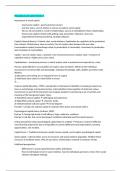Summary
Managing Social Capital Samenvatting (jaar 2 PEW/People management)
- Course
- Institution
NL: Dit zijn alle college aantekeningen van het vak managing social capital. Hiervoor moest je per thema (4 totaal) ook artikelen lezen (3 per thema) dus in totaal 12 artikelen. Deze zijn ook samengevat toegevoegd aan het document. Compleet overzicht van het vak. Ik heb in 1x een 8,5 gescoord doo...
[Show more]



